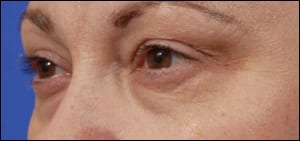

Recessions may not be good for the economy or for elective cosmetic surgery practices, but they do often inspire innovation to meet the needs of more cost-conscious elective surgery patients.
Responding to the times, Daniel J. Leeman, MD, plastic surgeon and medical director of New U Plastic Surgery in Austin, Tex, looked for a less expensive, nonsurgical alternative to blepharoplasty and found it in a technique he calls “nonsurgical periorbital rejuvenation.”
“Part of the reason why I got my arms around this procedure was due to the economy. People weren’t willing to spend a lot of money to have a surgical procedure like blepharoplasty, yet they wanted to have something that made the face look better,” Leeman says.
He has been using Dysport as a cosmetic neuromodulator, as well as a dermal optical thermolysis (DOT) CO2 fractional laser from DEKA, Firenze, Italy, for other procedures in his practice. Thinking about how to develop more cost-effective treatment for his patients, Leeman realized that he could marry the two products to create a combination therapy that was noninvasive, was less expensive than blepharoplasty, and would offer patients a brief recovery time.
A full blepharoplasty procedure can typically cost between $2,000 and $2,500 for the upper eyelids and about the same price for the lower eyelids. In addition, the procedures take 2 weeks or more to heal, he says. On the other hand, Leeman’s nonsurgical periorbital rejuvenation therapy costs patients around $1,000 for the whole area.
HOW IT WORKS
Leeman’s procedure is a combination therapy that can be applied in the office on the same day or separately over 2 days. First, he applies the Dysport injections, mainly targeting the glabellar area. Also, he gives patients what he calls “chemical brow lifts”— two injections in the tail of the brow to help soften that area for a more natural elevation of the brow. Additionally, Leeman uses the Dysport to target crow’s feet.


Leeman employs Dysport for his technique, but he says that Botox can be used instead. However, using Dysport has several advantages, he notes: From a marketing perspective, Dysport is new and more “cutting edge.” Second, it costs less than Botox. Third, Leeman reports that Dysport’s onset is a bit faster than Botox injections. “Our patients are seeing a result a little quicker than we’d normally see with the Botox treatment,” he says.
Once the injections are done, Leeman uses a DOT CO2 fractional laser on the same day. He applies the fractional laser in a straight line across the upper arch of the brows and then at the lid-cheek junction, and then feathers down from there.
He goes over the skin one or two times depending on the severity of the crow’s feet. “If someone has a really well-developed deep, deep crow’s feet, I’ll hit those first on a rectangle pattern where we really focus a lot of the energy on those swirly, deeper lines,” he says. “I’ll then go back on a square pattern and treat on top of that, double stacking in almost a two-pass approach.”
Leeman notes that the settings can also vary. If patients have more recovery time available, he may be a little more aggressive and increase the energy output.
“Typically, the setting is about 25 watts, and we use a spacing of about 300 to 400 microns,” he explains. “The dwell time or how long each dot of the laser is on is somewhere around 1,200 to 1,800 microseconds.”
As with Botox, Leeman says that good results can be obtained from many fractional CO2 lasers, but he cautions that there is a learning curve and that one should seek training for this procedure.
Typically, the laser goes over the arch of the eyebrow to the lid-cheek junction, a prominent area in which it is difficult to hide blemishes from an overly aggressive laser treatment. Therefore, proper feathering technique is important for good results, he notes.
“There is a little technique that has to be learned,” he says. “We have to blend it in there to the lid-cheek junction and at the upper aspect so that it looks even when it all heals.”
Physicians need to perform perhaps a dozen cases or so to achieve good, predictable results and be able to evaluate the aggressiveness of the treatment, he warns.
Recovery time is typically between 5 and 10 days. Aggressive treatments may be as long as 14 days, whereas the blepharoplasty recovery time can be at least 2 weeks and still have some swelling and possibly some bruising.
The procedure is designed for patients who want to target lax or puffy skin, sun damage, wrinkles, and fine lines around the eyes. The result is well-rounded eye rejuvenation without making any incisions or having a long downtime.
“We’ve seen some powerful results in just opening their eyes. People have been amazed on how much of a difference and how quick the recovery time is,” Leeman says.
Having these successful results with periorbital rejuvenation has led Leeman to begin developing other combination therapies. “I really think we have to start thinking more about combination treatments to achieve better results in a less invasive fashion,” he says, adding that currently he is working on a new DOT CO2-based skin-tightening technique.
Tor Valenza is associate editor of PSP. He can be reached at [email protected].




